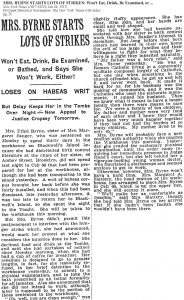On October 16th, Planned Parenthood of New York reached its 100th anniversary. It grew from a small birth control clinic created in Brownsville, Brooklyn by Margaret Sanger, her sister Ethel Byrne, and Fania Mindell. At the clinic, they distributed birth control, as well as pregnancy planning advice and information. Even though the three women were arrested for distributing obscene material and jailed, their efforts led to changes in the law allowing for birth control and sex education in the years to come. In 1921, the clinic became the American Birth Control League, which changed its name to the Planned Parenthood Federation of America in 1942.
What does this have to do with Mount Sinai? Margaret Sanger and her younger sister, Ethel Byrne, were nurses. Mrs. Byrne graduated from The Mount Sinai Training School for Nurses in 1909. The sisters did not always get along, but they were united in the believe of women having the right to plan their families. Mrs. Byrne protested her sentence and her jail term of 30 days and launched a hunger strike, which brought a great deal of attention to their cause. The hunger strike lasted for five days, and then she was forcibly fed by prison doctors. Mrs. Sanger and women civic leaders, including Anne Van Kirk, the Superintendent of The Mount Sinai Hospital Training School, appealed for her release. The Governor granted the request on February 1st when Sanger promised that her sister would never break the Comstock law again. Byrne was taken to her sister’s house for care, but this episode damaged their relationship. Byrne did not actively participate in the birth control movement after this.
Ethel Byrne’s later years were quiet. She moved to Massachusetts and returned to nursing. She died in 1955. In 1962, Alan F. Guttmacher, MD left his post as Chairman of OB-GYN at The Mount Sinai Medical Center to become the President of Planned Parenthood. The Mount Sinai connection continued.

